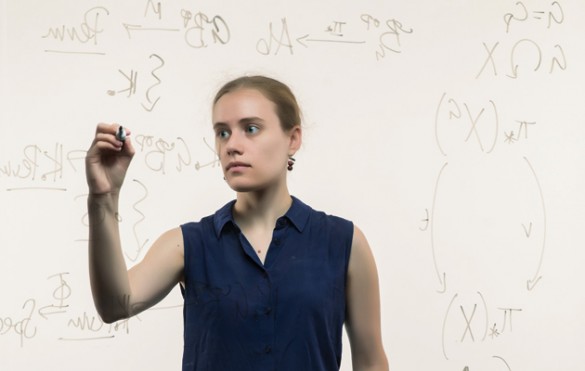
When Anna Marie Bohmann was growing up in Minneapolis, she enjoyed school in general—and math in particular—but had no idea that making a career in mathematics was even possible.
In high school, however, she took some university math classes and did so well that her high school math teacher suggested that she consider majoring in mathematics when she went to college. “Getting a Ph.D. sounded cool,” Bohmann said.
When she was accepted to Massachusetts Institute of Technology as an undergraduate, Bohmann also considered physics as a possible major. “But when I got into levels beyond calculus, I found mathematics to be increasingly compelling,” she said. “[rquote]It’s amazing what you can do with nothing but your brain.”[/rquote]
Bohmann also learned that she had a talent for languages, so she double majored in math and Spanish language and literature. After graduating from MIT, she got a master’s degree in Spanish literature at New York University. “For a while I seriously thought about going into Spanish lit, but I realized I would miss the math. I tried out the other pathway until I knew mathematics was what I wanted to do,” she said.
Bohmann enrolled in the graduate program in mathematics at the University of Chicago, earning her masters degree in 2007 and doctorate in 2011. From there, she moved to a postdoctoral fellowship at Northwestern University. In 2014 she also put in a stint as a postdoctoral fellow at the Mathematical Sciences Research Institute in Berkeley, California, before moving to Vanderbilt.
Bohmann’s research area is called “algebraic topology.” Abstract algebra is a major area in advanced mathematics that focuses on generalizing the structures required to manipulate numbers. Topology is concerned with the properties of spaces, particularly those that are preserved under deformations such as bending and stretching.
“Algebraic topology,” she explained, “is using algebra to understand spaces, not just familiar three-dimensional spaces but also multidimensional spaces.”
Bohmann gives the example of the circular floor plan of the house in which she grew up. If you took a piece of string and unrolled it as you walked around the house, then tied the two ends together, it would be impossible to pull the string out without cutting it.
“That makes the space ‘nontrivial’ and fundamentally different from the space in a single room,” she said. “As long as there aren’t any columns in the room, if you lay down a piece of string around the edges and tie them together, you can easily pull the string out. That means the room is a ‘trivial’ space.” By identifying different types of spaces in such a fashion and using algebraic techniques to analyze them, mathematicians like Bohmann can derive a surprising amount of information about how they behave.
“I really enjoy the way that mathematics helps you think about things,” Bohmann said. “When you are in school, you know that there are always answers to the problems you are given. That isn’t the case in research. You don’t know if an answer exists, so it is incredibly gratifying when you find one.”
In addition to mathematics, Bohmann enjoys knitting, local cuisine and old-time and classical music. “I’m really excited to be here,” she said.
View the complete list of new university faculty for 2015-16.
View the complete list of new medical faculty for 2015.